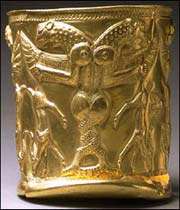Elamite history (part 1)
Elamite history can be divided into three main phases: the Old, Middle, and Late, or Neo-Elamite, periods. In all periods Elam was closely involved with Sumer, Babylonia, and Assyria, sometimes through peaceful trade, more often through war.
In like manner, Elam was often a participant in events on the Iranian Plateau. Both involvements were related to the combined need of all the lowland civilizations to control the warlike peoples to the east and to exploit the economic resources of the plateau.
Old Elamite Period
The earliest kings in the Old Elamite period may date to approximately 2700 BCE. Already conflict with Mesopotamia, in this case apparently with the city of Ur, was characteristic of Elamite history. These early rulers were succeeded by the Awan (Shuster) dynasty.
The 11th king of this line entered into treaty relations with the great Naram-Sin of Akkad (c. 2254 - c. 2218 BCE). Yet there soon appeared a new ruling house, the Simash dynasty (Simash may have been in the mountains of southern Luristan).
The outstanding event of this period was the virtual conquest of Elam by Shulgi of the 3rd dynasty of Ur (c. 2094 - c. 2047 BCE).
Eventually the Elamites rose in rebellion and overthrew the 3rd Ur dynasty, an event long remembered in Mesopotamian dirges and omen texts. About the middle of the 19th century BCE, power in Elam passed to a new dynasty, that of Eparti. The third king of this line, Shirukdukh, was active in various military coalitions against the rising power of Babylon, but Hammurabi (c. 1792 - c. 1750 BCE) was not to be denied, and Elam was crushed in 1764 BCE. The Old Babylon kingdom, however, fell into rapid decline following the death of Hammurabi, and it was not long before the Elamites were able to gain revenge. Kutir-Nahhunte I attacked Samsuiluna (c. 1749 - c. 1712 BCE), Hammurabi's son, and dealt so serious a defeat to the Babylonians that the event was remembered more than 1,000 years later in an inscription of the Assyrian king Ashurbanipal. It may be assumed that with this stroke Elam once again gained independence. The end of the Eparti dynasty, which may have come in the late 16th century BCE, is buried in silence.

Middle Elamite Period
After two centuries for which sources reveal nothing, the Middle Elamite period opened with the rise to power of the Anzanite dynasty, whose homeland probably lay in the mountains northeast of Khuzestan.
Political expansion under Khumbannumena (c. 1285 - c. 1266 BCE), the fourth king of this line, proceeded apace, and his successes were commemorated by his assumption of the title ‘Expander of the Empire.’ He was succeeded by his son, Untash-Gal (Untash (d) Gal, or Untash-Huban), a contemporary of Shalmaneser I of Assyria (c. 1274 - c. 1245 BCE) and the founder of the city of Dur Untash (modern Chogha Zanbil).
In the years immediately following Untash-Gal, Elam increasingly found itself in real or potential conflict with the rising power of Assyria. Tukulti-Ninurta I of Assyria (c. 1244 - c. 1208 BCE) campaigned in the mountains north of Elam. The Elamites under Kidin-Khutran, second king after Untash-Gal, countered with a successful and devastating raid on Babylonia.
In the end, however, Assyrian power seems to have been too great. Tukulti-Ninurta managed to expand, for a brief time, Assyrian control well to the south in Mesopotamia, Kidin-Khutran faded into obscurity, and the Anzanite dynasty came to an end.
Other links:
Ancient Cities and Archaeological Hills, Bushehr
Population and Ethnic Groups of Iran